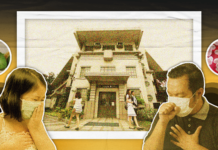MISGUIDED information about suicide may be a trigger for another suicide case.
For Renz Argao, a clinical psychologist in the University who specializes in psychological trauma, media’s role in reporting about suicide is crucial as misreporting could lead to a dangerous “Werther effect.”
This psychosocial phenomenon is defined as a sudden rise of suicide cases triggered by a widely publicized suicide. It is also known as “copycat suicide,” taken from the novel The Sorrows of Young Werther by Johann Wolfgang von Goethe. Published in 1774, it tells the story of lovelorn Werther who was surprised by the sudden death of his friend, and took his own life.
The novel was banned in Leipzig, Denmark and Italy because it allegedly caused copycat suicides.
“People hear that there is a way (suicide) that they can use, especially if they relate to the problem. If they have thoughts of ending their life, they will think that maybe it is a sign,” Argao said.
He discouraged the media from reporting suicide cases because of the sensitivity of the topic, arguing that without proper guidance, reporting could be detrimental. Suicide can be contagious, and the idea of suicide itself is dangerous, he said.
Instead, reports should tackle suicide prevention, ways to identify people who have suicidal behavior, and what can be done to help them.
The Billie Holiday song “Gloomy Sunday,” for instance, is not a song that causes suicide, but the idea that it triggers suicide could lead people to commit the act, Argao explained.
Marc Reyes, a professor from the College of Science and a clinical psychologist, also stressed the importance of the need to talk about suicidal behavior.
“We have to first establish that suicide is not a disorder, suicide behavior is technically a symptom or a consequence of a kind of problem,” he said.
The causes of suicide are complex and cannot easily be pinpointed, he added.
“It requires suicide autopsy to figure out the main reason why the individual ended his or her own life,” he said.
In 2008, a Thomasian architecture student allegedly killed himself because of his thesis. The following month, it was clarified by his parents that the thesis was not the cause of the suicide, but a lot of other things.
The Student Suicide Prevention Act of 2005, a law authored by the late senator Miriam Defensor, requires schools to offer suicide awareness and prevention programs.
Although the University is already offering lectures and seminars, for Argao and Reyes, they are still not enough.
“It will help of course, but we need to do more regarding informing people because students don’t take it seriously.” Argao said.
Red flags of suicide
The first thing to do in order to help people with suicidal behavior is to realize that they need help. Reyes and Argao shared some of the “red flags” of suicide.
“A person who have thoughts of suicide will usually talk about it. It may be through social media or through jokes, to lessen the weight they are carrying. It is not true that people who crack jokes about ending their own life will not really do it. There is a big chance that they will,” Reyes said.
A sudden change of mood and giving away precious gifts that are sentimental to the individual are also symptoms of suicide behavior. The individual will try to “tie loose ends,” asking forgiveness from people they had quarreled or argued with.
“A sad or depressed victim will suddenly be bright and happy from just prior to the accident, because of the idea that they had found a solution to their problem,” Argao said.
The most obvious sign of a suicidal individual is visible self-harm, not only by cutting or slashing, but also by too much alcohol or drug intake. Some experience insomnia. Others feel aloof most of the time.
Self-harm
There is a special case common among the youth, called Non-Suicidal Self Injury (NSSI) wherein the act self-harm is present but the idea of ending one’s life is not, Reyes said. As a matter of fact, they cut or hurt themselves to “feel alive.”
“NSSI does not belong to the same category of suicide behavior. In fact, we are still studying it but both of them must be addressed properly,” Reyes said.
Argao and Reyes agree that the first thing to do with individuals showing red flags is to talk to them. Simply informing them that someone is willing to listen is already a huge help.
“A suicide first aid responder must ask if the individual has made concrete plans already. And lahat ng mga nasa plans niya ilayo na sa kaniya,” Reyes said.
It is also important to never make the individual feel guilty. An example is telling the individual to think of his or her parents. It will give the individual an idea that he or she is selfish and will add to the weight of the problem, thus, another reason to go forward with the plan.
Family and friends of the individual should also be alerted, except when they are the source of the problem. If the family or friends are the cause, it’s better to go to the school’s guidance office.
Both psychologists also said it would be better to refer the person to a professional. The UST Graduate School Psychotrauma Clinic offers free psychological services to anyone.
Reyes said suicidal individuals are often not sure of what they are doing. Even if they do have a concrete plan, there is still doubt inside their minds.
“When you are talking to a person who is suicidal you think of that ambivalence because that means there is still hope. You could anchor on that uncertainty and make them change their mind,” he said.












